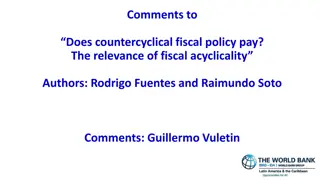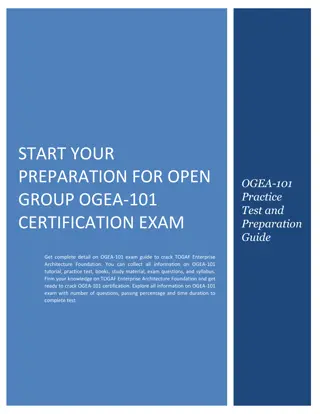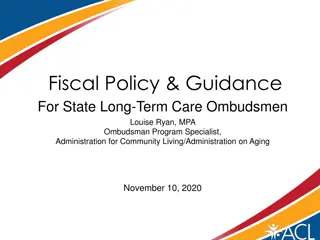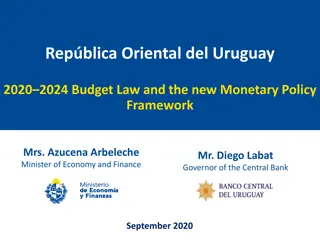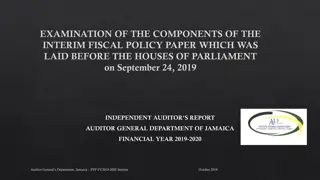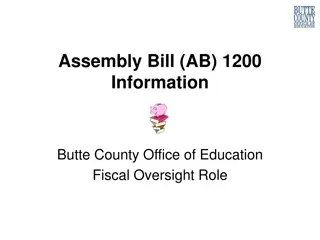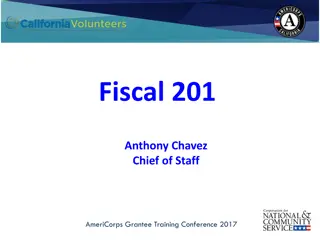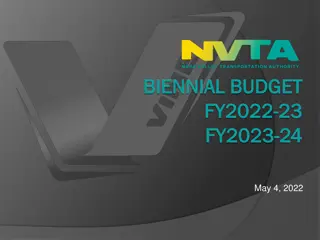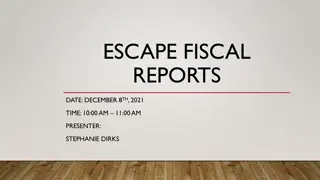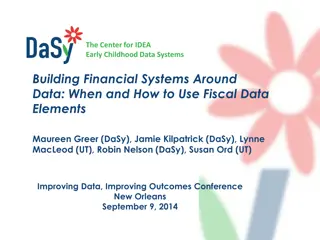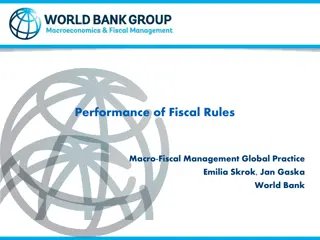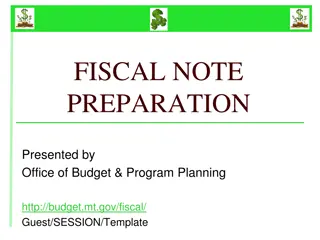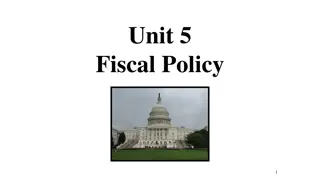
Fiscal Law and Controls Overview
This detailed material covers the essentials of fiscal law and controls in the context of appropriations, expenses, and statutory authority, presented through images and concise explanations. It delves into the legal framework governing the use of public funds, including the separation of powers and key principles like bona fide needs, necessary expenses, and statutory regulations. The content emphasizes the importance of proper authorization and adherence to fiscal regulations to ensure responsible financial management and effective resource allocation.
Download Presentation

Please find below an Image/Link to download the presentation.
The content on the website is provided AS IS for your information and personal use only. It may not be sold, licensed, or shared on other websites without obtaining consent from the author. If you encounter any issues during the download, it is possible that the publisher has removed the file from their server.
You are allowed to download the files provided on this website for personal or commercial use, subject to the condition that they are used lawfully. All files are the property of their respective owners.
The content on the website is provided AS IS for your information and personal use only. It may not be sold, licensed, or shared on other websites without obtaining consent from the author.
E N D
Presentation Transcript
ARMY STANDARD TRAINING PACKAGE
FISCAL LAW 101: PURPOSE AND TIME The Fiscal Controls of Purpose & Time
AGENDA Introduction Purpose Overview Express Statutory Authority Necessary Expense Doctrine Investment/Expense Threshold Systems Time The Bona Fide Needs Rule Key Terms Determining the Year of the Need Multi-year Appropriations Life Cycle of a Fund Current as of 26 February 2020
INTRODUCTION Appropriated funds enable commanders to equip and train the force; and fight our nation s wars. Current as of 26 February 2020
Fiscal Framework Separation of Powers Art. I, Art. I, 8: shall have the power to collect taxes, pay debts, and provide for the common defense. 8: The Congress Art. II, Art. II, 2: shall be Commander in Chief of the Army and Navy of the United States. 2: The President Current as of 26 February 2020
FISCAL FRAMEWORK Art. I, 9: No money shall be drawn from the treasury, but in the consequence of an appropriation made by law. United States v. MacCollom: The rule is the expenditure of public funds is proper only when authorized by Congress, not that public funds may be expended unless prohibited by Congress. 426 U.S. 317 (1976) Current as of 26 February 2020
FISCAL CONTROLS Time Amount Purpose Necessary Expense Necessary Expense Bona Fide Need Bona Fide Need 31 U.S.C. 1502, 1522 31 U.S.C. 1502, 1522 Antideficiency Act Antideficiency Act 31 U.S.C. 1301(a) 31 U.S.C. 1301(a) 31 U.S.C. 1341 31 U.S.C. 1341- -4, 1511 4, 1511- -17 17 Purpose what do you want to spend the money on? Time when do you want to spend the money? Amount how much money do you want to spend? Current as of 26 February 2020
AGENDA Introduction Purpose Overview Express Statutory Authority Necessary Expense Doctrine Investment/Expense Threshold Systems Time The Bona Fide Needs Rule Key Terms Determining the Year of the Need Multi-year Appropriations Life Cycle of a Fund Current as of 26 February 2020
PURPOSE Appropriations shall be applied only to the objects for which the appropriations were made except as otherwise provided by law. 31 U.S.C. 1301(a) How do I know if I have authority? Look to authorizations, appropriations, and organic legislation. Authorization: the legal basis for appropriations (NDAA). Appropriation: establishes budget authority by authorizing agencies to incur obligations (DODAA). Funds The pots of money created by the appropriation. Each fund is different with respect to purpose, time, and amount. Current as of 26 February 2020
PURPOSE Express Statutory Purpose General Statutory Purpose Current as of 26 February 2020
EXPRESS STATUTORY PURPOSE Sec. 8071 of the 2016 Consolidated Appropriations Act: Of the amounts appropriated for Defense-Wide Procurement and RDT&E, $487,595,000 shall be for the Iron Dome short range rocket defense program. Current as of 26 February 2020
GENERAL STATUTORY PURPOSE 1. Expense necessary and incident to the purpose? A. Is it logically related to the appropriations purpose? B. Will it make a direct contribution to an authorized function? 2. Not Prohibited by Law 3. Not Provided for Otherwise
#1 - NECESSARY AND INCIDENT A. Is this expense logically related appropriations purpose? logically related to the B. Will this expense make a direct contribution to an authorized agency function? direct contribution Current as of 26 February 2020
#2 NOT PROHIBITED BY LAW The expenditure must not be prohibited by law. Examples 1. The Leahy Amendment. 2. GTMO Detainee Transfers. Current as of 26 February 2020
#3 NOT PROVIDED FOR OTHERWISE Use the most specific funding source. There must not be a more specific funding source that applies to the expenditure. For example: Aircraft must be procured with aircraft procurement, not other procurement. Current as of 26 February 2020
MAJOR DOD APPROPRIATIONS Operations and Maintenance Military Personnel Procurement Research Development Test & Evaluation Military Construction Current as of 26 February 2020
OPERATIONS AND MAINTENANCE O&M funds are for EXPENSES the cost of resources consumed in operating and maintaining the DoD. For Example: Office Supplies & Paper Utilities Fuel Maintenance Services Current as of 26 February 2020
PROCUREMENT Procurement funds are for INVESTMENTS the cost to acquire durable items such as equipment. Procurement (Various) Specific types of procurement funds: aircraft, missiles, weapons and tracked vehicles, ammunition, etc. Other Procurement (OPA) General investment items that are durable in nature and will benefit the Government in subsequent fiscal years. Current as of 26 February 2020
MILITARY PERSONNEL MILPER funds are used for pay, allowances, and subsistence. Current as of 26 February 2020
RDT&E Research, Development, Test, and Evaluation funds are for basic and applied scientific research, development, test and evaluation, including maintenance, rehabilitation, lease and operation of facilities and equipment. For Example: The Defense Advanced Research Projects Agency (DARPA). Current as of 26 February 2020
MILITARY CONSTRUCTION Used to fund construction of military installations and facilities. $0 - $4M = O&M (Garrison Cdr) Notice to IMCOM >$750K $4M - $9M = UMMC (Sec Army) Congressional notice req d 14 days prior to expending funds +$9M = MILCON (Congress) 2015 NDAA Current as of 26 February 2020
INVESTMENT/EXPENSE THRESHOLD Expense items (consumable) are funded with O&M. Investment items (durable) are funded with Procurement. But as an exception, Congress allows agencies to fund investment items with O&M when the item does not exceed a certain threshold currently $350K. Expense (any amount) O&M Investment < 350K O&M Investment > 350K Procurement Current as of 26 February 2020
SYSTEMS The cost of investment items that form a system are aggregated for the purposes of the investment/expense threshold. What is a System ? Are the components designed primarily to function within the context of a whole? Will the components be interconnected to satisfy the requirement? Cannot fragment or piecemeal the acquisition of a system to avoid exceeding the O&M threshold. Current as of 26 February 2020
TIME Agenda The Bona Fide Needs Rule Key Terms Determining the Year of the Need Multi-year Appropriations Life Cycle of a Fund Current as of 26 February 2020
THE BONA FIDE NEEDS RULE Policy: Government agencies may not purchase goods or services they do not require. The bona fide needs rule requires both the timing of the obligation and the bona fide need to be within the fund s period of availability. The balance of an appropriation or fund limited for obligation to a definite period is available only for payment of expenses properly incurred during the period of availability or to complete contracts properly made within that period of availability. - 31 U.S.C. 1502(a) Current as of 26 February 2020
KEY TERMS Fiscal Year Budget concerns operate on a fiscal year timeline, running from 1 October to 30 September (FY25 runs from 1 Oct 24 - 30 Sept 25). Period of Availability The period of time for which appropriations are available for new obligations. O&M: 1 Years Military Personnel: 1 Years RDT&E: 2 Years Procurement: 3 Years MILCON: 5 Years Current as of 26 February 2020
LIFE CYCLE OF A FUND 30 Sept the Appropriation EXPIRES 30 Sept the Appropriation CLOSES Expired (but available to adjust old obligations) Closed Available FY1 FY 2 FY 3 FY 4 FY 5 FY 6 FY 7 O&M = 1 Year PoA
KEY TERMS Commitment The administrative reservation of funds, in anticipation of obligation to ensure sufficient funds exist. Liability does not attach can be undone. Obligation A definite act that creates a legal liability on the part of the Government for the payment of goods and services ordered or received (e.g. awarding a contract, placing an order, receiving a service). Disbursement The actual payment to the vendor or contractor for goods or services to satisfy a contract. Current as of 26 February 2020
THE BONA FIDE NEEDS ANALYSIS Current Year Funds for Current Year Needs The Obligation & the Need must occur within the fund s Period of Availability. The Year of the Need Supplies: BFN exists when the supplies will be used. Services: BFN exists when the services will be performed. Construction: BFN exists when the construction must start in order to be complete by the required delivery date. Current as of 26 February 2020
THE BFN OF A SUPPLY Generally agencies must obligate funds from the fiscal year in which the supplies will be used. Supplies used in a future fiscal year are the bona fide need of the future fiscal year unless an exception applies. Exceptions (Supplies Only) Delivery Lead Time Exception Production Lead Time Exception Stock-Level Exception Current as of 26 February 2020
DELIVERY LEAD-TIME EXCEPTION Agencies may use current year funds for future year use IF you currently require the item & delay is due to delivery lead-time. Provided: The delay is due to delivery: The time between contracting and delivery is not excessive; and The supplier requires the delivery lead-time (Agencies may not set or request a delivery date beyond the normal delivery lead-time). Current as of 26 February 2020
PRODUCTION LEAD-TIME EXCEPTION Agencies may obligate current year funds for a supply for a future year use, in order to have the supply when required due to production. Provided: The intervening period is needed for production; & The supply is NOT commercially available. Current as of 26 February 2020
STOCK-LEVEL EXCEPTION Agencies may obligate current year money to replace stock items consumed during the current fiscal year, even when they will not use the items until the next fiscal year, in order to maintain adequate stock levels of readily available common-use standard supplies. The policy behind the exception is to prevent interruption of on-going operations between fiscal years. Fiscal year-end stockpiling of supplies in excess of normal usage requirements is prohibited. Current as of 26 February 2020
THE BFN OF A SERVICE Generally, the bona fide need for services does not arise until the services are rendered or performed. Categories Non-Severable Services: funds current at K award. Severable Services: funds current at time of service. Current as of 26 February 2020
NON-SEVERABLE SERVICE CONTRACTS Defined: A service is non-severable when the service produces a single or unified outcome, product, or report and cannot be subdivided for separate performance in different fiscal years because the value results from the full completion of the service. BFN Impact: The Government must fund non-severable service contracts completely up front with funds available for obligation at the time the contract is executed. Current as of 26 February 2020
SEVERABLE SERVICE CONTRACTS Defined: A service is severable when it can be separated into components that independently meet a need of the Government (continuing/recurring). BFN Impact: Agencies must fund severable service contracts with funds available for obligation on the date the contractor performs the service. Current as of 26 February 2020
10 U.S.C. 3133 Severable Service contracts may cross FYs: The DoD may obligate current year funds to finance a severable service contract that starts in the current fiscal year and ends in the next fiscal year, provided the period of performance does not exceed 12 months and the service contract is fully funded at time of contract award. This exception only applies to severable services and does NOT apply to multi-year appropriations. Current as of 26 February 2020
THE BFN OF CONSTRUCTION Construction is treated as a non-severable service contract (unified outcome) and are a bona fide need of the fiscal year in which construction must begin in order to meet the required delivery date. Construction contracts may constitute a bona fide need of the current fiscal year even though performance is not completed until the following fiscal year. Current as of 26 February 2020
THE BFN OF CONSTRUCTION Considerations: Normal weather conditions; Required delivery date; The date the Government intends to make facilities, sites, or tools available to the contractor; and The degree of actual control the Government has over when the contractor may begin work. The further these variables push into the next FY, the more likely the construction is a BFN of the next FY. Current as of 26 February 2020
THE BFN OF TRAINING Contracts for single training courses are considered similar to non-severable service contracts. Training contracts may be obligated in full with fiscal year money current at the time performance begins, even if the course extends into the next fiscal year. Current as of 26 February 2020

